NW9 is officially called “The Hyde” by the Post Office. Where? I hear you say.

Hardly anyone will have heard of The Hyde so we will go and seek the places people might have heard of in NW9 , such as Colindale and Kingsbury.
We start with Kingsbury, at the Post Office, at 439 – 441 Kingsbury Road. Turn left out of the Post Office and soon our first stop is on the left.
Stop 1: Kingsbury station
Kingsbury station was the catalyst for development here in the 1930s.
The station was built by the Metropolitan Railway as part of their new branch to Stanmore and opened in December 1932, just before the creation of London Transport in 1933. This then became the Metropolitan line under London Transport.
As we heard in NW8 additional tracks were added to give more capacity between Finchley Road and Baker Street. And it was the Stanmore branch trains which went into the new tunnels and became a branch of the Bakerloo line. So Kingsbury became a Bakerloo line station from 1939. It was then transferred to the Jubilee line when that opened in 1979.
The design of this station looks like an overgrown country cottage and is very much the style adopted by the Metropolitan Railway. How very different from the other stations built around this time by the Underground company and by the Southern Railway which were much more modern in style, using concrete and glass. And how very different from the rest of the street on either side which consists of typical 1930s parades of shops.
Our next stop is almost immediately across the road.
Stop 2: site of Kingsbury’s Odeon cinema
Today you see an Aldi supermarket flanked by two small shop with creamy tiling, but this was the site of the Kinsgbury Odeon.
It was built for and operated by Oscar Deutsch’s Odeon chain, opening in May 1934. It seated 724 in the stalls and 279 in the balcony.
It was renamed the Gaumont in 1950, presumably as there were quite a few other Odeons locally. But it reverted to the Odeon name in 1964 and finally closed in September 1972.
The auditorium, foyer and main entrance facade were demolished and replaced by a Sainsbury’s supermarket. And today this is now Aldi. But the ghost of the old building survives in the form of two original shop units on either side.
Now walk back along Kingsbury Road and when the shops run out you will see a park ahead which includes a little children’s play area. Our next stop is just behind that play area.
Stop 3: Roe Green Park
We are specifically going to a building just inside the park. It used to be something called the Veteran’s Club but is currently being refurbished as a Children’s nursery.
And here just by the front door is a little plaque erected by the Borough of Wembley, commemorating that this is where John Logie Baird experimented with sending television signals in 1929.
As of now you can get right up to the door to see the plaque but I guess that might be more difficult when it becomes a nursery. This by the way seems to be the nearest NW9 gets to having a blue plaque!
There is also a stone tablet commemorating the same connection put up y the Wembley History Society
But it is quite hard to read!
Now we are going to Colindale which is a bit of a walk, so I suggest you hop on a 204 bus. Return to the main road and there is a stop called Valley Drive just near here. After about 6 stops you will be at The Hyde (the stop to get off at is called Colindeep Lane).
You can walk if you really want. Go along Kingsbury Road, turn left into Roe Green and then right at the roundabout into Hay Lane. The Hyde is over the hill at the end of Hay Lane.
From the bus stop walk back along the main road. If you have walked turn right at the end of Hay Lane.
Stop 4: Another former Odeon cinema
This is in the distinctive Odeon cinema style and indeed it was opened in January 1935 by Oscar Deutsch as part of his Odeon chain – just down the road from Kingsbury where the Odeon had opened the previous year.
It is unusual in that it has a long facade with a wide central recessed entrance with shop units on each side with flats above. It even had a car park at the rear.
You feel that it ought to have a tower but apparently it never did. Inside seating was provided in a semi-stadium plan with 726 seats in the stalls and 279 in a raised balcony area which did not overhang the stalls.
This Odeon was closed in September 1960. It was empty for many years but was re-opened by an independent operator in November 1967 as the Curzon Cinema. It was taken over by Classic Cinemas and renamed Classic Cinema in January 1972. Having been split into two cinemas in 1973, it finally closed in July 1981.
After laying empty for a few more years, the building became the Colindale Snooker Club in 1986. And it remains a snooker club today.
And you can see it as a fleeting image of the Snooker Club in the video for George Michael’s 2004 song “Round Here” at about 1 minute 52 seconds. Don’t blink or you will miss it.
This song is about George Michael’s childhood and how he remembers his first day at school. Although he was born in East Finchley, the family moved to Kingsbury soon after his birth and so George Michael spent a lot of his childhood in Kingsbury.
The words of this song actually reference a place called “Kingsbury Park” but I think this may actually be Roe Green Park – which apparently also features briefly in this video.
However the family moved to Bushey when George was a young teenager and it was here he met Andrew Ridgeley and formed Wham!. Wonder what would have happened if the family had stayed in Kingsbury.
Turn back and go along Edgware Road (or it may be “The Hyde”, not too sure). Just after the junction with Grove Park, there is a large building site, which is our next stop.
Stop 5: Former Oriental City shopping centre
This was the location of a rather unusual shopping centre called “Oriental City”.
This had been originally developed by a Japanese company called Yaohan but when they went bankrupt in the late 1990s, it was sold to a group of Malaysian businessmen who restyled it as the “Oriental City” shopping centre. As the name suggests it specialised in selling oriental goods with a food court and a supermarket. It was sold again in 2006 and plans were made to redevelop it as a B & Q store and housing.
After much protest, it finally closed in 2008 but nothing much happened. There was an attempt to restart the shopping centre with some of the former tenants but this got nowhere.
Finally a new scheme came forward and was approved in 2013. The site was cleared for development in the summer of 2014 and the plan now is to have a Morrison’s supermarket on the site with housing.
Now cross the road and search out Merit House, which is a twelve story office block clad in shiny glass.
Stop 6: Merit House (site of former tram and trolley bus depot)
The anonymous looking block called Merit House at 508 Edgware Road occupies the site of the Metropolitan Electric Tramways Depot.
Here in 1910, the first trials in Britain of a trolleybus took place and then the depot became a trolleybus garage in 1936. It had been intended to convert all tram routes to trolleybuses but the war intervened and after the war it was decided to standardise with diesel motor buses.
The garage name was changed to Colindale in 1950 to avoid confusion with nearby Hendon bus garage. With the abandonment of trolleybuses, it was closed and then demolished in 1962. In fact the land behind the depot was used from 1959 to 1962 by the George Cohen 600 Group for scrapping London’s trolleybus fleet which numbered almost 1900 vehicles.
So this site represents both the birth and death of the trolleybus in London.
The building is currently under renovation and looks set to become the new headquarters for an organisation called “Utility Warehouse” which is a company that specialises in selling broadband, phone and energy supply packages.
Now walk back along Edgware Road and turn left into Colindale Avenue.
We cross a little bridge over the delightfully named Silk Stream. Sadly it does not look as lovely as its name.
After the entrance to the Public Health England site on your left, watch out for the terrace of houses on the left with this nice little plaque (it is above the doors to 117 – 123)
Not sure how old this is. But maybe it is not so old and was because a couple called Colin and Linda lived here.
Our next stop is ahead just across the road
Stop 7: Former Newspaper Library
This building was until 2013 the Newspapers section of the British Library.
The British Library first came to Colindale in 1902 when they built a new depository. The building was expanded in the early 1930s and became the newspaper library in 1934. The older part of the building was destroyed by bombing in 1940 and was rebuilt in the mid 1950s.
The Library has an almost complete collection of British and Irish newspapers since 1840, although London editions of national daily and Sunday newspapers are complete back to 1801. The collection is now being made available on line (although it is not free and they still have a long way to go before the whole collection is accessible on line)
The physical collection is now divided between the British Library sites at St Pancras in London and Boston Spa in Yorkshire.
This site looks like it is going to be another housing development.
Stop 8: Pulse (a new housing development)
The land almost opposite the former British Library Newspaper Library is already in the process of being redeveloped. This new development is called “Pulse” and guess what – it is on the site of an old Hospital.
Colindale Hospital was opened in 1898 as the “Sick Asylum for the Central London District”. In 1907 the Government began to use the site for making vaccines. It closed as a hospital in the 1990s, but as we saw some offices of Public Health England are still located here. I think that was actually built as the Blood Transfusion Centre administrative offices in about 1990.
But the hospital site proper is still in the process of being developed.
If you venture into the estate you will find one old building (it is identified by the letter LB on the plan – which I guess means “Listed Building!)
It is actually called Jenner Court. Edward Jenner (1749 – 1823) pioneered smallpox vaccine, the world’s first vaccine, so that is clearly the reason. He could not have worked here, given he had been dead over 75 years by the time the site was used as a hospital.
And you can round the back and see this little courtyard
When I was taking this picture, a workman doing something with waste bins came up to me and said: “Nice aren’t they. Even the one which is where the Mortuary was.”
Retrace your steps to the main road and turn left.
Stop 9: Colindale Station
The station opened on 18 August 1924 on the north side of Colindale Avenue, on what was then the ‘Hampstead and Highgate Line’ extension to Edgware. The platforms are located underneath the road, on both sides of the bridge.
The original station, a classical style building designed by Underground Architect Stanley Heaps, was severely damaged during the Blitz in September 1940. A simple temporary timber structure was built after the bombing and this was only replaced in 1962. The station has been rebuilt again fairly recently.
Fascinating fact: T. E. Lawrence (better known as Lawrence of Arabia) regularly used the station when he was stationed at the nearby Hendon Aerodrome and apparently he used the pen name “Colin Dale” in articles he wrote for The Spectator during 1927 and 1928.
Keep walking along Colindale Avenue until you get to the roundabout and here take the right hand road.
The area ahead of you was once Hendon Aerodrome. It was used for aviation from 1908 until the 1960s. The site of the aerodrome is now occupied by the Grahame Park housing estate, Hendon Police College and the RAF Museum.
In 1911 a man called Claude Grahame-White established a flying school here. The Aerodrome was “lent” to the Admiralty in 1916 and eventually taken over by the RAF in 1919. After a protracted legal battle, the RAF bought Grahame-White’s aerodrome in 1925.
Hendon Aerodrome later became RAF Hendon. After flying ceased there in the 1960s it was largely but not completely redeveloped as a housing estate which was named Grahame Park after Grahame-White.
Walk along Aerodrome Road and on your right is the site of the Police College which is undergoing a massive redevelopment at the moment.
Stop 10: Hendon Police College (The Peel Centre)
The Peel Centre is the main training establsihment for London’s Metropolitan Police Service.
It was originally called the Metropolitan Police College when it first opened in 1934, to train the “officer” class. It closed in September 1939. After the war, there was some debate about whether it should reopen, as in 1948 a National Police College was established in the Midlands. However it did but as the Metropolitan Police Training School for all levels.
When the Royal Air Force left Hendon in the 1960s, it was decided to rebuild the college. The new colllege was called the Peel Centre, named after Sir Robert Peel. It was opened by HM the Queen on 31 May 1974, forty years to the day after her uncle (the future King Edward VIII) opened the original Metropolitan Police College.
Along Aerodrome Road within what now seems to be the college site, there is on the right an intriguing looking building with an interesting sculptural frieze. But there is no sign to indicate what was here and why there is this frieze.
But there is this sign on one of the doors.
This must have been the works of Franco Illuminated Signs. They opened on Aerodrome Road in 1922. They had made the lights for the Franco British Exhibition of 1908 and the company name was later abbreviated to ‘Franco’. They were also known for the neon signs found in Piccadilly from the 1920s to the 1970s. But sadly there seems to be no recognition of their existence here except perhaps this little substation sign.
Across the road is a new development called Beaufort Park for reasons I have not been able to establish. Go down Heritage Avenue which is the main road through the estate.
Stop 11: Beaufort Park
This is a new development was apparently built on part of the RAF site . It looks decidedly unenglish, more like the kind of things you see in Spain.
In fact the advertising at the site does mention a “Mediteranean Style Boulevard”. Sadly though they cannot promise mediterranean style sunshine!
But weirdly, the developers have chosen to call this main “boulevard” across the estate “Heritage Avenue”
A distinct lack of imagination displayed here.
At the end of Heritage Avenue turn right and our next stop is ahead on the right.
Stop 12: RAF Museum
The Royal Air Force Museum London is also located on the former Hendon Aerodrome. It is dedicated to the history of aviation and the Royal Air Force.
The museum here was officially opened by HM The Queen on 15 November 1972.
An original World War I Grahame-White aircraft factory hangar was relocated a few years ago to the RAF Museum. This houses the museum’s World War I collection and is named the Grahame White Factory.
So we are now at the end of our NW9 walk. It has proved to be a more interesting area than at first it might have seemed. It has its transport heritage. Not just the former aerodrome and today the RAF museum but also the role it played at the beginning and end of the trolleybus in London. We also saw how it was until recently the home of the vast national newspaper archive and learned of its role in the early production of vaccines.
Return to Colindale station for onward travel. Go back along Grahame Park Road and at the roundabout take Colindale Avenue to reach the station.

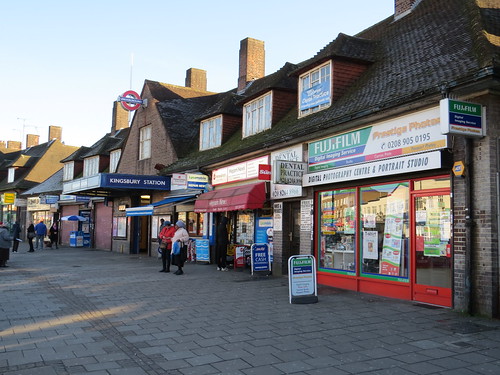
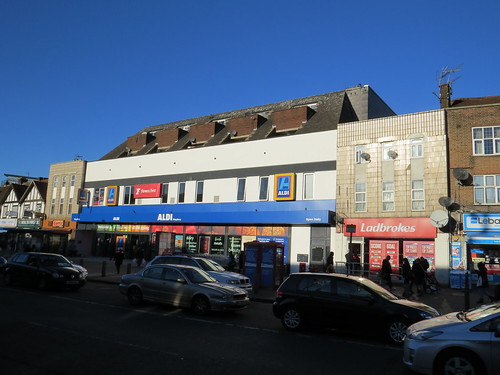

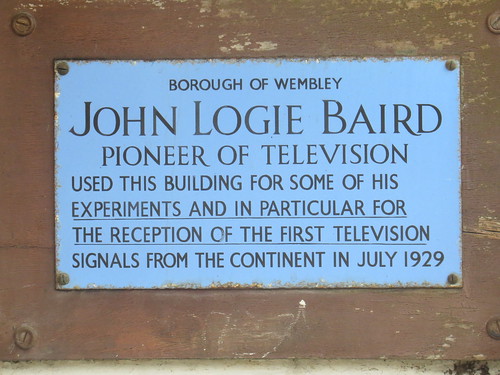



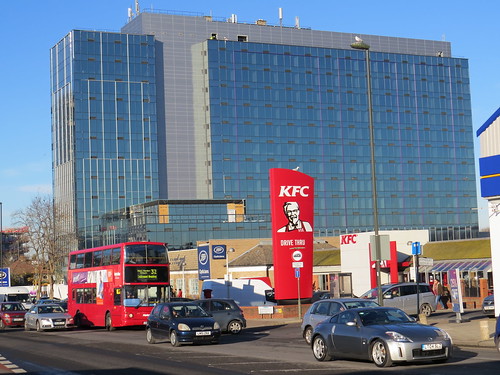






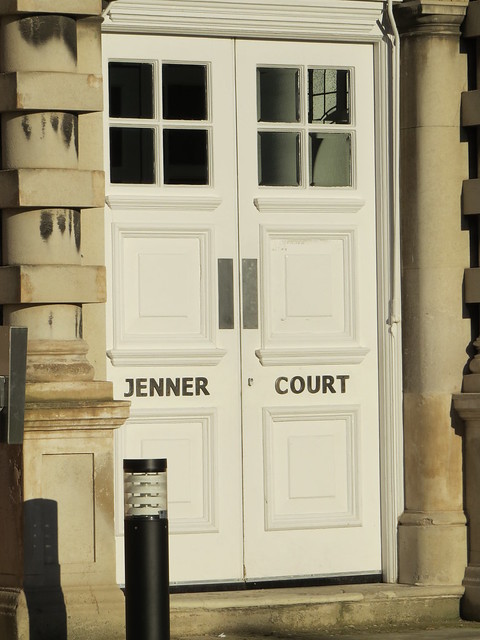



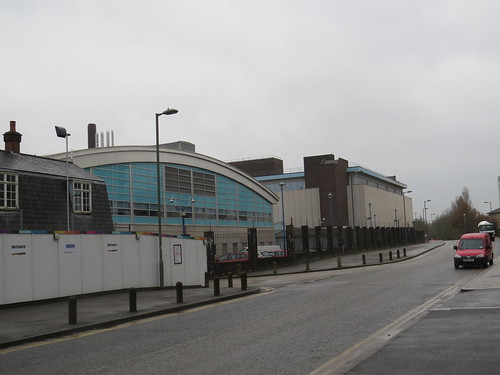
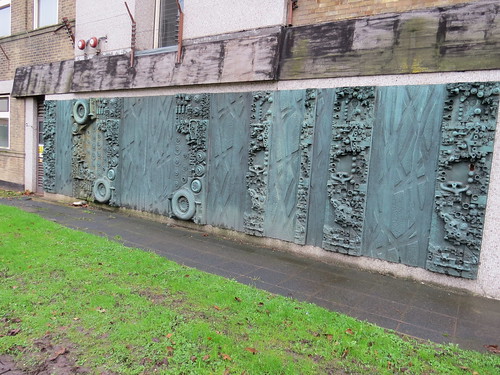


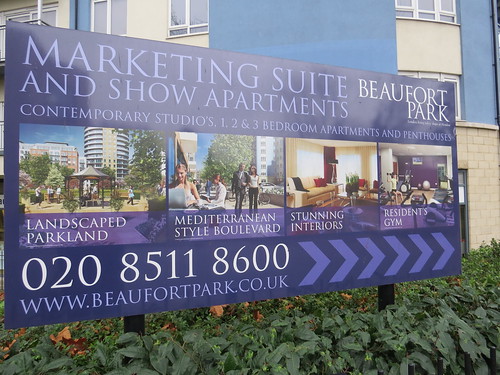
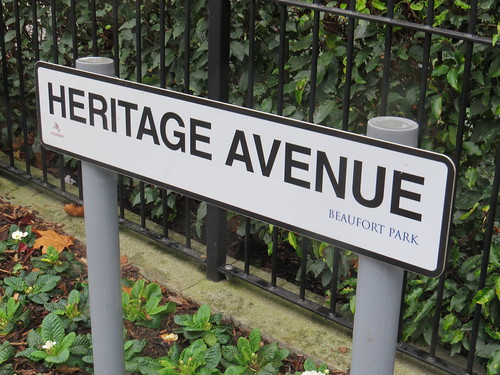

For many years, probably up until about the Millennium, at the north east corner of the Edgware Road/Colindale Avenue junction, were two “ghost signs”, still visible high up on the brickwork of the buildings there. One read “London Propellor Company” and the other read “Studebaker Depot”. Both indicative of the previous history of the area.
The unknown freize is the Metropolitan Police Driving School in Aerodrome Road.
The sculptural frieze was the mural next to the entrance for the police driving school, hence the tyres in it. It was originally black, but now been painted blue. I should know I delivered the post here on my van delivery.
Lovely post. I had a great time using your blog and Google Streetview to retrace my steps on my first London trip in 2003 when I walked from Colindale up to the RAF museum. A lot of houses seem to have been added since then! Oh, and you missed a local landmark:just beyond the museum on Avion Cresent is Hannant’s, the Mecca of plastic modellers.
http://www.hannants.co.uk/info/
That was my destination then and it will be my destination again soon, summer 2015 hopefully.
Cheers/Thomas (in Sweden)